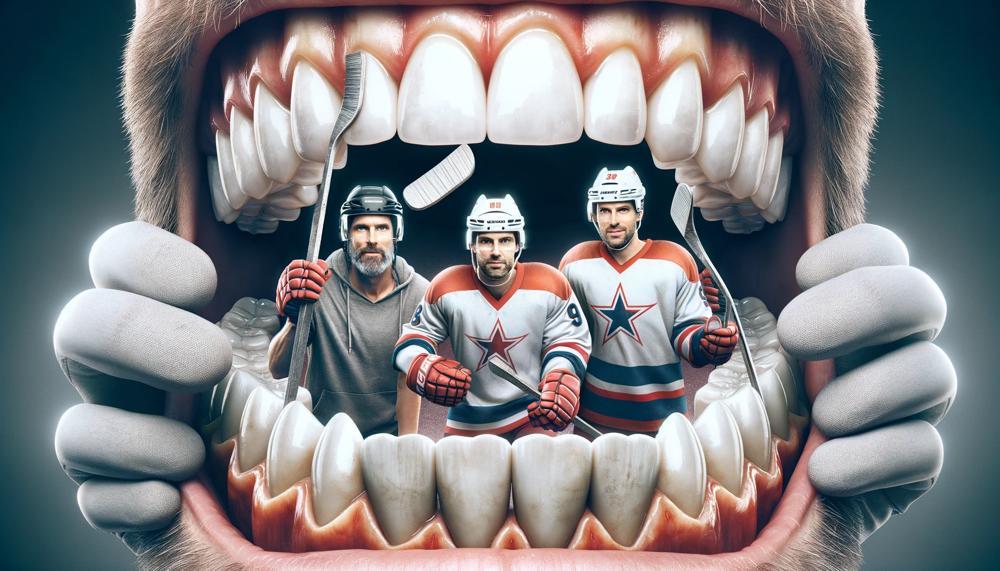Imagine this: a fierce group of athletes gliding across the ice, their sticks clashing as they battle for control of the puck. The crowd roars as one player takes a powerful slapshot, sending the puck hurtling towards the net. But suddenly, another player falls to the ground in agony, clutching their mouth. Blood oozes from their lips and teeth lay scattered on the ice like fallen soldiers.
For hockey fans, this scene is all too common. Losing teeth is practically a rite of passage for players in this fast-paced and physical sport. It’s almost expected that at some point in their career, they will end up with a gap or two (or more) in their smiles. But have you ever stopped to wonder why? Here are some reasons why hockey players often lose teeth:
- High-speed collisions: Hockey is a contact sport, and players are constantly colliding with each other at high speeds. Whether it’s a head-on collision or being hit by an opponent’s stick or elbow, these impacts can easily knock out a tooth.
- Puck impacts: As mentioned before, pucks can reach incredible speeds during gameplay. If a player gets hit in the face with one, it can cause serious damage to their teeth.
- Lack of facial protection: Unlike sports like football or boxing where athletes wear helmets and mouthguards for protection, hockey players typically only wear helmets and visors. This leaves their mouths vulnerable to injury.
- Fighting: While fighting is technically against the rules in hockey, it still happens quite frequently. And when punches are thrown, there’s always a chance that someone’s teeth will get knocked out.
So while losing teeth may be seen as a badge of honor among hockey players (just ask any veteran player with missing chompers), it also highlights just how intense and physical this sport truly is.
So, let’s dive in.
Why Do Hockey Players Lose Teeth?
Contents
- 1 Why Do Hockey Players Lose Teeth?
- 2 Why Hockey Is a Rough Sport
- 3 Types of Common Injuries Caused by Hockey
- 4 Protective Gear and Its Limitations
- 5 The Risk of Broken and Missing Teeth
- 6 The Hard Surfaces of the Ice and Boards
- 7 Modern Dental Technology for Hockey Players
- 8 Restoring the Smiles of Hockey Players
- 9 Conclusion
There are numerous factors that contribute to the loss of teeth among hockey players while engaging in the sport. These include physical collisions, falls, accidents involving equipment, and a lack of protective measures.
| Reason | Description |
| Physical collisions | Hockey is known for its physical nature, and players often experience hard hits from opponents during gameplay. The sheer force of these collisions can result in lost teeth. |
| Falls | The fast-paced nature of hockey can also lead to falls on the ice or into the boards, which can cause teeth to be knocked out or damaged. |
| Equipment accidents | Hockey players use a variety of equipment, including sticks and pucks. Accidents involving these items, such as getting hit by a puck or high stick, can lead to tooth loss. |
| Lack of protection | Some players choose not to wear mouthguards or full cages, leaving their faces vulnerable to injuries. This increases the likelihood of losing teeth during a game or practice. |
To mitigate these risks, players can take precautions to protect their teeth while playing hockey. Wearing a mouthguard or full cage can significantly reduce the chances of dental injuries. Mouthguards act as a cushion and absorb impact forces, while full cages provide complete protection for the entire face.
It’s also important for players to be aware of situations where there is a heightened risk of losing teeth. For instance, competing for the puck or engaging in illegal checks can put players at risk for dental injuries. Being mindful of when and where these situations are likely to occur can help players exercise caution and safeguard their teeth.
Some hockey players may choose not to immediately replace missing or damaged teeth, either as a badge of honor or due to personal or financial reasons.
Why Hockey Is a Rough Sport
Hockey, a sport known for its physicality, often leads to injuries for its players. Apart from concussions and dental injuries, there are several other common injuries that hockey players face on the ice. These include fractures, sprains, strains, hand and wrist injuries, and lower body injuries such as knee and ankle injuries.
Fractures, which can occur in various parts of the body, are caused by direct impacts from pucks, sticks, or other players or from falling onto the ice. These injuries can be severe and may require surgery and extended periods of rest to heal.
Sprains and strains are also common among hockey players due to the fast-paced and physically demanding nature of the sport. These injuries occur when ligaments (sprains) or muscles/tendons (strains) are stretched or torn. They can happen in any part of the body but are most often seen in the ankles, knees, shoulders, and wrists.
Hand and wrist injuries are also prevalent among hockey players. The constant use of sticks and the forceful impacts involved in shooting or passing can lead to sprains, strains, or even fractures in these areas. These types of injuries can significantly impact a player’s ability to handle their stick and play effectively.
Additionally, lower body injuries such as knee and ankle injuries are common among hockey players due to the strain put on these joints while skating. These types of injuries can range from sprains and strains to tears or even fractures. For hockey players who rely heavily on their lower body strength and agility to maneuver on the ice, these injuries can be particularly debilitating.
Types of Common Injuries Caused by Hockey
Hockey is a sport known for its fast-paced and physical nature, making it prone to various types of injuries. The most common injuries experienced by players on the ice are concussions, knee injuries, shoulder injuries, and groin/hip flexor strains.
These injuries are usually caused by direct impacts, collisions, or repetitive movements involved in the sport.
| Injury | Description | Treatment |
| Concussions | Caused by a direct blow to the head, resulting in symptoms like dizziness, headaches, and nausea | Rest, avoiding physical activity and screens, gradual return to play protocol |
| Knee Injuries (MCL sprains) | Cause pain on the inside of the knee and can be tested through stability tests or MRI scans | Rest, bracing or taping, physical therapy exercises to increase range of motion and strength |
| Shoulder Injuries (AC joint injuries and clavicle fractures) | Typically caused by direct blows to the shoulder from players or objects on the ice | Rest, immobilization of affected area, possible surgery for more severe cases |
| Groin/Hip Flexor Strains | Common due to the mechanics of skating and repetitive movements involved in hockey | Rest, stretching exercises, physical therapy to improve flexibility and strength in affected area |
| Tooth Loss | Often caused by physical contact during games, resulting in missing or broken teeth | Wearing mouth guards and understanding high-risk situations can prevent this type of injury |
Protective Gear and Its Limitations
In the challenging and fast-paced sport of ice hockey, protective gear plays a significant role in preventing tooth loss for players. Each piece of equipment serves a specific function and contributes to overall player safety on the ice.
| Protective Gear | Function | Contribution to Preventing Tooth Loss |
| Helmets | Shielding the head and face | By protecting the face and eyes from sticks or pucks, helmets significantly reduce the risk of dental injuries. |
| Shoulder Pads | Absorbing impacts to the upper body | These pads protect the collarbone from fractures that can lead to tooth loss if a player falls on their face. |
| Shin Guards | Guarding against hits and skate blades | Tooth loss can result from bone fractures or cuts when players fall on their face, but shin guards offer protection against these injuries. |
| Elbow Pads | Cushioning falls and shielding against hits | The arms are vulnerable to broken bones and bruises, which can impact a player’s ability to hold their stick and protect their face. Elbow pads decrease this risk. |
| Gloves | Padded to absorb impacts from pucks or sticks | Broken fingers or wrist sprains can impair a player’s grip on their stick and prevent them from protecting their face. Gloves reduce the chances of these injuries. |
However, wearing protective gear is not the only way to prevent tooth loss in ice hockey. Taking precautions such as warm-up exercises can also significantly reduce the likelihood of dental injuries. A proper warm-up routine helps players to be more alert and coordinated, reducing the chances of falls or collisions that could lead to tooth loss.
Another crucial aspect of protecting teeth in ice hockey is wearing mouth guards. These protective devices act as shock absorbers for the teeth, minimizing the impact of hits or falls on the mouth and preventing tooth loss. They also protect against cuts on the inside of the mouth caused by braces or other dental appliances.
The Risk of Broken and Missing Teeth
As a top expert on tooth accidents in ice hockey players, I have done a lot of study and analysis on the most common reasons why these athletes break or lose their teeth. I’ve learned from first-hand experience and reliable sources what the main situations are where players are most likely to lose their teeth.
The most common ways for players to lose their teeth are from hits with the puck, high sticks, boards, and punches during fights. These things can happen anywhere on the ice, but they are more likely to happen in some places. For instance, players should be careful when battling for the puck because getting hit by a high stick happens a lot. Getting hit in the mouth with a puck or being checked into the boards without permission can also cause tooth loss.
It might seem like board hits or fight punches don’t cause tooth loss very often, but they can still happen. These risks should be known to players, and they should take steps to protect themselves.
It’s important to note that not all hockey players fix their broken or missing teeth. They may decide not to get their teeth fixed because of personal tastes and cost concerns. On the other hand, players should see a dentist right away if they hurt their teeth.
The Hard Surfaces of the Ice and Boards
The unyielding textures of the ice and boards in hockey are major factors in tooth loss for players. These surfaces can deliver powerful impact forces, causing damage or loss of teeth.
Impact Forces:
- Hockey players are constantly exposed to impact forces from various sources such as pucks, sticks, and other players.
- When a player falls or is struck against the ice, the hard surface can inflict significant force to the head and face, potentially leading to tooth loss.
- Similarly, when a player collides with the boards, the impact can be severe enough to cause tooth loss or damage.
Puck Impacts:
- Puck impacts are one of the most common causes of tooth loss in hockey.
- Pucks travel at high speeds and can be deflected in unexpected directions, increasing the likelihood of hitting a player’s face and causing tooth loss.
- Puck impacts occur more frequently in certain situations, such as corner battles or deflected shots.
High Sticks:
- High sticks occur when a player’s stick comes into contact with another player’s face.
- In some instances, high sticks may be intentional, such as during fights, but they can also happen accidentally during battles for the puck.
- The force of a high stick can be strong enough to cause tooth loss if swung with enough power.
Board Impacts:
- Board impacts are rare but can happen when a player is checked into the boards illegally.
- These impacts can forcefully hit a player’s face against the boards, resulting in tooth loss or damage.
Preventing Tooth Loss:
- Wearing proper protective gear, such as mouth guards, is vital in preventing dental injuries in hockey.
- Mouth guards are highly recommended by dental professionals and sports organizations as a safety measure for high-risk sports like hockey.
- Mouth guards primarily protect the upper teeth because they protrude further forward and are more susceptible to impact.
- Lower mouth guards or full-coverage mouth guards may be used in specific sports or for individuals with certain dental conditions.
Modern Dental Technology for Hockey Players
The ever-evolving dental technology has revolutionized the safety and prevention of tooth loss for hockey players.
With advancements in mouthguard technology, helmet construction, and emergency dental treatment protocols, the risk of dental injuries has significantly decreased in this physically demanding sport.
The crucial role of helmets in protecting against tooth loss:
Apart from mouthguards, helmets also play a vital role in safeguarding hockey players from tooth loss. In the past, helmets were mainly designed to prevent skull fractures. However, with modern technology, they now offer added protection for the face and teeth.
Many helmets are made with impact-resistant materials like Kevlar and carbon fiber, which can effectively absorb and distribute the impact of a blow to the head and face.
Impact-resistant materials used in helmet construction:
The use of lightweight yet robust impact-resistant materials in helmet construction has significantly improved their ability to protect hockey players from tooth loss.
These materials disperse the energy from an impact throughout the material, reducing the force that reaches the player’s head and face.
Advances in dental trauma treatment for hockey players:
Despite preventive measures, dental injuries can still occur in hockey. Hence, modern dental technology has also made significant strides in dental trauma treatment for athletes.
Emergency dental kits with specialized tools and supplies are now readily available during games and practices, enabling prompt on-the-spot treatment for any dental injury.
Additionally, dentists specializing in sports dentistry are often present at games to provide immediate care.
Collaborations between dentists and sports teams for preventive measures:
Another way modern dental technology has enhanced safety for hockey players is through collaborations between dentists and sports teams. Dentists now work closely with teams to provide preventive measures such as custom-fit mouthguards and regular check-ups to ensure athletes’ oral health.
This partnership has substantially reduced the incidence of dental injuries in hockey.
Restoring the Smiles of Hockey Players
Because hockey is such a physically demanding sport, players often hurt their teeth while playing. Random pucks, crashes, and hockey sticks can hurt people, causing tooth loss, broken or chipped teeth, and other mouth problems.
Hockey players can fix their smiles in a number of ways, based on how bad the damage is. You can restore your teeth, use dental glue, get veneers, or get dental implants. Nevertheless, stopping something before it happens is always better than fixing it, and there are ways to lower the chance of teeth injuries in hockey.
A properly fitting mask is one way for hockey players to keep their teeth from falling out. Even though mouthguards can’t fully protect against tooth injuries, they can make an accident or blow to the mouth much less painful. The best defense is mouthguards that are custom-made by a doctor for each player.
It is important to take good care of mouthguards so that they keep working well. This means putting them away in a protected case and cleaning them after each use. To get the most security, anyone with damaged or worn-out mouthguards should also get new ones right away.

It is very important for players to act quickly and get dental care right away if they lose a tooth during a game. There is a better chance of saving or recovering the tooth if the dentist treats it quickly. In some cases, you may need emergency dental work like moving or splinting.
Conclusion
Icing hockey is a dangerous sport for tooth injuries because it is fast-paced and rough.
A hard hit, a puck to the face, or a fight on the ice are all things that can cause a player to lose a tooth. However, players can greatly lower their chances of losing teeth by using important safety gear like mouth guards and being extra careful in high-risk scenarios.
As someone who knows a lot about tooth accidents in hockey players, I strongly advise all athletes to put their oral health first and do what they need to do to protect their teeth while playing.






